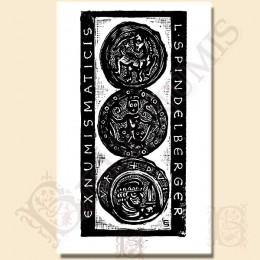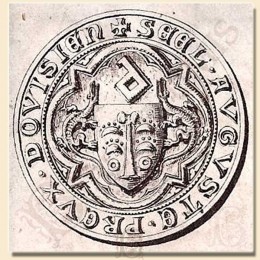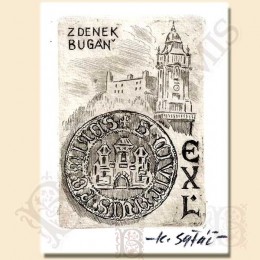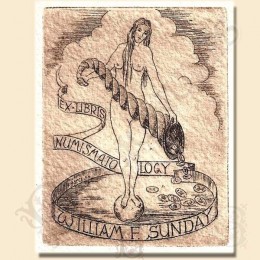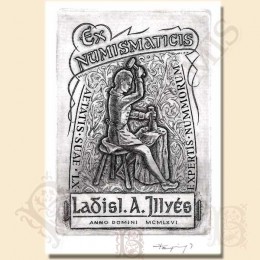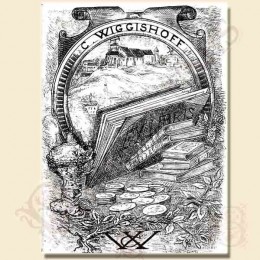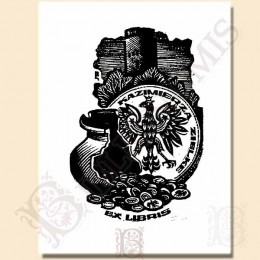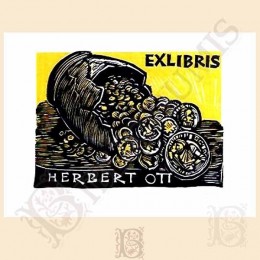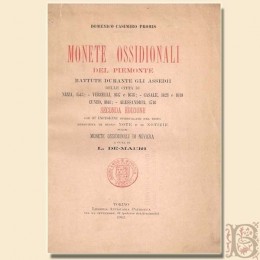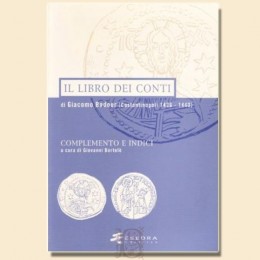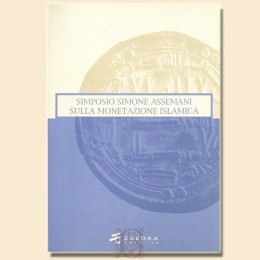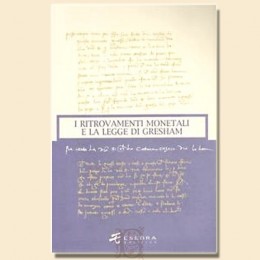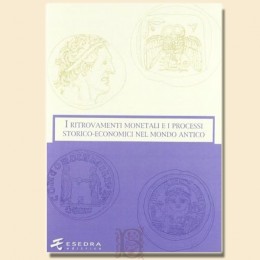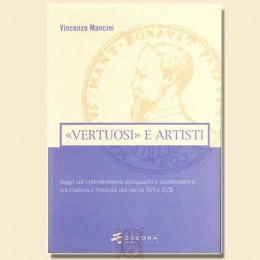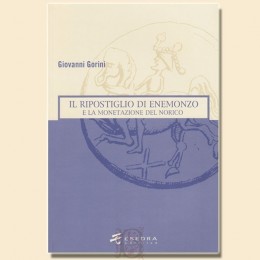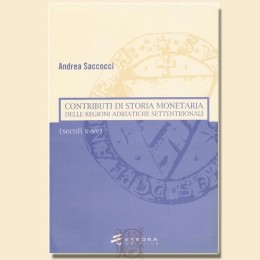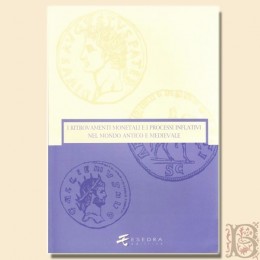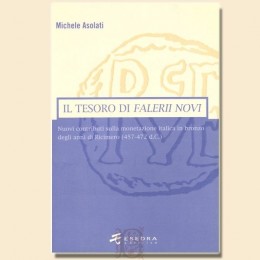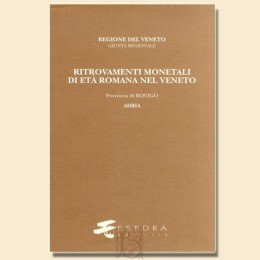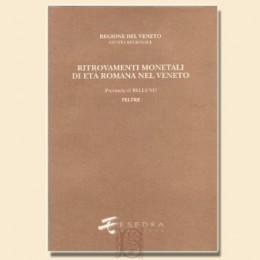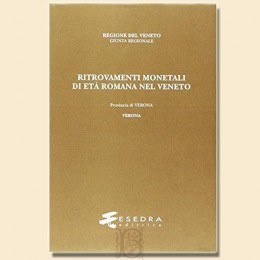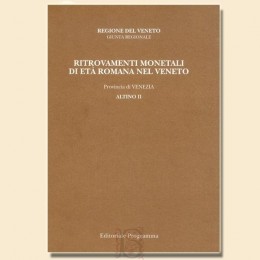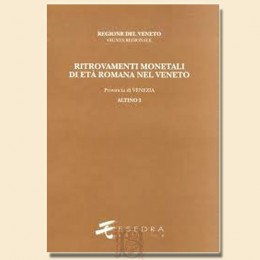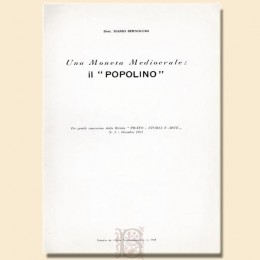Resources
Complete catalog
Welcome to the central section of Biblionumis, a true point of reference for all numismatics enthusiasts. Here, the passion for coins merges with a carefully curated selection of books that span centuries of monetary history and culture. Our Complete catalog is an invaluable resource for collectors, scholars, and curious minds, offering a diverse range of volumes that explore every facet of coin science. In this section, you will find a vast collection of books dedicated to ancient, medieval, modern, and contemporary coins, including rare and specialized texts on related disciplines such as sigillography, medallic art, and paper money. Each work is meticulously selected, ensuring excellent editorial quality and authoritative content that will enrich your knowledge of numismatics. This catalog is not just a collection of books; it is an essential guide that will accompany you through the history of coins, delving into crucial topics such as coinage, iconography, and historical contexts that have influenced monetary issues. Our catalog is constantly evolving, with new acquisitions and rarities regularly added, offering you new discoveries and opportunities to enrich your personal library. Whether you are looking for a reference work for your studies, a rare piece for your collection, or the perfect gift for a numismatics enthusiast, here you will find exactly what you need. Explore our Complete catalog now and be captivated by the wealth of numismatic knowledge.
-
Ex libris L. Spindelberger
€25.00Numismatic bookplate by L. Spindelberger, woodcut by Erich Schöner, Austria, second half of the 20th century, signed by the author, 144x87 mm.
Erich Schöner, artist, has made many engravings, including ex libris.
Large.
Very good condition. Extremely rare.
-
Ex libris Auguste Preux
€28.00Numismatic bookplate by Auguste Preux, copper engraving, France, mid 19th century, 49x47 mm.
Auguste Preux (1822-1879), scholar of sphragistics, numismatics and heraldry, put together an important collection of over 1200 seals, from the twelfth to the nineteenth century.
Very good condition. Extremely rare.
-
Ex libris Zdenek Bugan
€30.00Numismatic bookplate by Zdenek Bugan, intaglio engraving by Karel Safar, Prague, second half of the 20th century, signed by the author, 111x82 mm.
Zdenek Bugan, painter and engraver, has participated in over 130 group exhibitions around the world.
Karel Safar (1938-2016), artist, professor at the University of Benares, made paintings and several engravings, including ex libris.
Very good condition. Extremely rare.
-
Ex libris William F. Sunday
€30.00Numismatic bookplate by William F. Sunday, chalcographic engraving by Fritz Botel, Holland, mid 20th century, signed by the author, 117x84 mm.
William F. Sunday (1889-1967), well-known American numismatic collector, author of several articles published in specialized journals, president of the Rochester Numismatic Association since 1924.
Fritz Botel (1896-1984), artist, made several engravings, including ex libris.
Very good condition. Extremely rare.
-
Ex libris Ladisl. A. Illyés
€30.00Numismatic ex libris of Ladisl. A. Illyés, Intaglio engraving by Tempinszky, Budapest, 1966, signed by the author, 120x85 mm.
István Tempinszky (1907-1979), artist, made several former books for numismatists.
Very good condition. Extremely rare.
-
Ex libris Jacques Charles...
€28.00Numismatic bookplate by Jacques Charles Wiggishoff, etching by Louis Aristide Bertrand, France, second half of the 19th century, 88x62 mm.
Jacques Charles Wiggishoff (1842-1912), French scholar, industrialist and politician. He was mayor of the eighteenth arrondissement of Paris, president of the Société des collectionneurs d'ex-libris, founding president of the Société du Vieux Montmartre, member of the Commission du Vieux Paris, and author of several publications including Les ex-libris uniques ou rarissimes, published in 1909.
Very good condition. Very rare.
-
Ex libris Kazimierza Zielke
€24.00Numismatic bookplate by Kazimierza Zielke, linocut by Leonenko Vasilij (opus 404), Ukraine, 1991, signed by the author, 132x97 mm.
Leonenko Vasilij, born in Ukraine in 1948, author of several ex libris with which he has participated in international exhibitions.
Large.
Very good condition. Very rare.
-
Ex libris Herbert Oct.
€26.00Numismatic bookplate by Herbert Ott, color woodcut by the artist Herbert Ott himself, Germany, 1978, signed by the author, 85x113 mm.
Herbert Ott, well-known engraver and creator of ex libris.
Very good condition. Extremely rare.
-
Promis, Piedmontese obsidional...
€90.00Domenico Casimiro Promis, Piedmontese obsidional coins. Beaten during the sieges of the cities of Nice 1543, Vercelli 1617 and 1638, Casale 1628 and 1630, Cuneo 1641, Alessandria, 1746. Second edition with 37 engravings interspersed in the text, enriched with new notes and news on the Novara obsidional coins. by L. De Mauri, Patristic Antiques Library, Turin 1903, pp. 44, richly illustrated, 24 cm, br. and.
Edition of 400 numbered and autographed copies by De Mauri, this is no. 76.
Membership stamp on the paperback and title page.
Slight traces of use on the paperback, otherwise exemplary in excellent condition.
Very rare.
-
Giacomo Badoer's book of...
€44.00The book of accounts by Giacomo Badoer (Constantinople 1436-1440). Complement and indexes, edited by Giovanni Bertelè, Esedra Editrice, Padua 2002, pp. 257, cm 27, br. and.
Numismatica Patavina, 2. Series directed by Giovanni Gorini.
New one.
-
Simone Assemani Symposium on...
€34.00Simone Assemani Symposium on Islamic Coinage. Padua, II International Congress of Numismatics and Monetary History. Padua 17 May 2003. Civic Museums at the Eremitani-Bottacin Museum (Library), Esedra Editrice, Padua 2005, pp. 253, richly illustrated, 27 cm, br. and.
Numismatica Patavina, 7. Series directed by Giovanni Gorini.
The volume collects the contributions proposed in the second International Numismatic Congress (Padua, May 2003) during which, in memory of the orientalist Simone Assemani (Rome 1752-Padua 1821), some of the most important scholars of Islamic numismatics met. After some insights into the role of Assemani, who is at the beginning of the studies of Islamic coinage, various aspects of this particular area of research are illustrated: relations with Western issues, finds in archaeological excavations and monetary circulation, collecting.
New one.
-
Monetary finds and Gresham's law
€32.00Monetary finds and Gresham's law. Proceedings of the III International Congress of Numismatics and Monetary History. Padua 28-29 October 2005, edited by Michele Asolati, Giovanni Gorini, Esedra Editrice, Padua 2006, pp. 222, richly illustrated, 27 cm, br. and.
Numismatica Patavina, 8. Series directed by Giovanni Gorini.
The expression "Gresham's Law" identifies the economic-monetary phenomenon according to which "bad money drives out good", that is, the practice that leads to spending, for the same face value, the coins with the worst metal content and to storing and accumulating those with better content. In the past, this practice had a fundamental importance and significant implications at a historical-economic level, but still today it continues to play a role, for example by pushing us to spend the most creased banknote and to keep the printable one. This book collects the contributions proposed during the III International Congress of Numismatics and Monetary History (Padua, October 28-29, 2005) on the theme of Gresham's Law and monetary finds. In particular, the results it had in the Greek, Celtic, Roman, Byzantine and medieval European world are examined in depth and its "paternity" is also discussed: attributed to Sir Thomas Gresham (ca. 1519-1579) in the second half of the nineteenth century , more likely, it can be traced back to Italian environments in which the phenomenon was already known and theorized a century earlier. The volume also includes as an appendix the re-edition of the contribution Uses and abuses of Gresham's Law in the History of Money by Robert Mundell, professor of Economics at Columbia University in New York and Nobel Prize in Economics in 1999.
New one.
-
Monetary finds and...
€35.00Monetary finds and historical-economic processes in the ancient world, edited by Michele Asolati, Giovanni Gorini, Esedra Editrice, Padua 2012, pp. 362, richly illustrated, 27 cm, br. and.
Numismatica Patavina, 12. Series directed by Giovanni Gorini.
This volume, which includes fourteen contributions, comes at the end of a research project funded by the Ministry of Education, University and Research that lasted over ten years. It was aimed at studying the problems relating to ancient coin finds with projections also in the medieval world in their broadest sense both chronologically and methodologically. Over the years, numerous Italian and foreign scholars have participated in this debate who have focused on some historical-economic aspects of the coin finds in the contexts of Greek and Roman society. These works, although they reflect different approaches and perspectives according to the personalities of the authors, nevertheless, as a whole, provide a very broad and articulated picture of the situation of studies in this sector of numismatic research at the beginning of the second decade of the 21st century. Each of them, with its own specificity, is part of a larger organism which as a whole offers itself to the free exchange of ideas with a critical and methodological approach. This initiative was born within the "school of Padua" which for several years now has developed a certain experience on historical and economic problems related to the phenomenon of monetary finds.
New one.
-
Mancini, Vertuosi and artists....
€29.00Vincenzo Mancini, Vertuosi and artists. Essays on antiquarian and numismatic collecting between Padua and Venice in the sixteenth and seventeenth centuries, Esedra Editrice, Padua 2005, pp. 141, richly illustrated, 27 cm, br. and.
Numismatica Patavina, 5. Series directed by Giovanni Gorini.
The volume collects some essays dedicated to the topic that lately is at the center of the most advanced studies in the field of art history: that of antiquarian, numismatic and artistic collecting. By rediscovering and making sources and archive papers speak, the author outlines the identity of some figures of collectors and art lovers active in close complicity in the sixteenth and seventeenth centuries between Padua and Venice. Alongside personalities not unknown to literature, the book brings out entirely new names - Gerolamo Querini, Francesco Assonica, Giovanni Galvano and others - who thus enter fully into the roster of the most important collectors of the time. The connected action of intellectuals commuting between the two poles sees the involvement of artists often of the first magnitude, such as Tiziano, Campagnola, Tintoretto, Vittoria, Tinelli. With the reconstruction of the individual figures, a more general picture of the relations between the intellectual circles of the university city and those of the capital of the Serenissima Republic during years of flourishing cultural development is recomposed.
New one.
-
Gorini, Enemonzo's closet and...
€28.00Giovanni Gorini, Enemonzo's closet and the coinage of Norico, Esedra Editrice, Padua 2005, pp. 162, richly illustrated, 27 cm, br. and.
Numismatica Patavina, 6. Series directed by Giovanni Gorini.
The fortunate occasion of the discovery in Friuli of a storage room of 40 tetradrams of the "Kugelreiter" type, associated with 359 republican Roman victors, made it possible to substantially modify the chronology of these issues. In fact, for this monetary series there can no longer be any reason for a chronology to exist at 60 BC. C. An attribution to the middle of the second century is preferable. to. C. for a whole series of numismatic, ponderal, epigraphic, typological and finally historical elements.
New one.
-
Saccocci, Contributions to the...
€32.00Andrea Saccocci, Contributions of monetary history of the northern Adriatic regions (X-XV centuries), Esedra Editrice, Padua 2004, pp. 250, richly illustrated, 27 cm, br. and.
Numismatica Patavina, 3. Series directed by Giovanni Gorini.
The purpose of this work is to scientifically illustrate the monetary characteristics of north-east Italy during the Middle Ages. However, it is precisely the attention to the men who are at the origin of every economic choice that has allowed the understanding of those mechanisms that made these regions a vast and highly homogeneous money market. Market that contributed not a little to the great mercantile success of the Serenissima.
New one.
-
Monetary finds and inflation...
€28.00Monetary finds and inflation processes in the ancient and medieval world. Proceedings of the IV International Congress of Numismatics and Monetary History. Padua 12-13 October 2007, edited by Michele Asolati, Giovanni Gorini, Esedra Editrice, Padua 2008, pp. 169, richly illustrated, 27 cm, br. and.
Numismatica Patavina, 9. Series directed by Giovanni Gorini.
The phenomenon of inflation, both as an increase in prices and as a debasement of money, is one of the most studied and debated in the studies of numismatics and ancient and medieval monetary history due to the undoubted repercussions on the contemporary world, which has always tried to limit it. the effects and to keep it under strict control. In fact, the real impact of the inflationary aspects on the economy of a historical period is very delicate and complex to study and understand, especially if we keep in mind the ancient and medieval monetary economies, which are sometimes quite precarious. This volume collects the contributions proposed during the IV International Congress of Numismatics and Monetary History (Padua, 12-13 October 2007) on the theme of the relationship between inflation and its effects on monetary finds. In particular, some aspects of the Greek and Roman world and the Italian medieval one are focused with a series of interventions by Italian and foreign scholars, who have faced this complex problematic analysis by proposing new solutions to old problems or advancing new research perspectives in the light of the documentation. that the continuous discoveries of coins, both isolated and in closets, bring to our attention for a critical and multidisciplinary approach.
New one.
-
Asolati, The treasure of Falerii...
€30.00Michele Asolati, The treasure of Falerii Novi. New contributions on the Italic bronze coinage of the Ricimer years (457-472 AD). With an appendix by Leonardo Allegretta, Esedra Editrice, Padua 2005, pp. 197, richly illustrated, cm 27, br. and.
Numismatica Patavina, 4. Series directed by Giovanni Gorini.
The imperial Roman coinage of the 5th century AD. C. still presents many aspects that have been poorly investigated, especially regarding the small coin in copper alloy. This volume contains the study of a treasure of late antique bronze coins found at the end of the 19th century in the area of Falerii Novi (now Falleri, Viterbo). "Rediscovered" after a century of oblivion, the treasure, which consists of just over 1780 specimens, offers new and important contributions to the knowledge previously possessed on the evolution of Italic bronze coinage of the second half of the fifth century AD. C., proving to be a historical-archaeological document of absolute importance. Particularly interesting are the ideas offered on the volumes and production rhythms of the official Western mints in this period, on the evolution of the weight of the nummus (the main bronze nominal of this era), as, on the other hand, on the identification of the zones. production of the numerous imitations that characterized this historical period. Finally, no less significant are the contributions that also contribute to defining certain aspects of the personality of one of the characters that most characterized the Italic political scene of this phase: Ricimer.
New one.
-
Roman coin finds in Veneto,...
€42.00Monetary finds from the Roman period in the Veneto, by Giovanni Gorini, with the collaboration of the Archaeological Superintendence of Veneto, Province VII: Rovigo. Volume II: Adria. Municipalities of: Adria, Ariano Polesine, etc., edited by Bruno Callegher, Esedra Editrice, Padua 2000, pp. XIII, 527, 22 tablets, 25 cm, hardcover ed. with gold titles on the spine, front plate and dust jacket.
At the top of the title page: Regione del Veneto. Regional Council.
New one.
-
Monetary finds from the Roman...
€33.00Monetary finds from the Roman period in the Veneto, by Giovanni Gorini, with the collaboration of the Archaeological Superintendency of Veneto, Province I: Belluno. Volume II: Feltre. Municipalities of: Arsiè, etc., edited by Caterina Galifi, Esedra Editrice, Padua 1998, pp. XIII, 260, 10 tablets, 25 cm, hardcover ed. with gold titles on the spine, front plate and dust jacket.
At the top of the title page: Regione del Veneto. Regional Council.
New one.
-
Monetary finds from the Roman...
€50.00Monetary finds from the Roman period in the Veneto, by Giovanni Gorini, with the collaboration of the Archaeological Superintendence of Veneto, Province III: Verona. Volume I: Verona. Municipality of: Verona, edited by Antonella Arzone, Federico Biondani, Dario Calomino, Esedra Editrice, Padua 2015, pp. XIII, 651, 23 tablets, 25 cm, hardcover ed. with gold titles on the spine, front plate and dust jacket.
At the top of the title page: Regione del Veneto. Regional Council.
This volume is completely dedicated to the description of the coins found over the decades in the city of Verona, including the localities annexed to the old city nucleus during the Fascist period. It represents the first detailed survey conducted for an area of particular interest, that of a large city in northern Italy, worthy of competing with Mediolanum and Aquileia. Furthermore, it is a work that concludes the series dedicated to the province of Verona, waiting for a final volume, relating to the closet in Albaredo d'Adige, to complete the picture of this western area of the region. It also marks a further stage in the scientific journey carried out by the other volumes dedicated to the coins found in the various provinces of Veneto, which is nearing its conclusion.
New one.
-
Monetary finds from the Roman...
€33.00Monetary finds from the Roman period in the Veneto, by Giovanni Gorini, with the collaboration of the Archaeological Superintendence of Veneto, Province VI: Venice. Volume II: Venice / Altino II. Municipalities of: Eraclea, Fossalta di Piave, Iesolo, Marcon, Meolo, etc., edited by Michele Asolati, Cristina Crisafulli, Editoriale Programma, Padua 1994, pp. XII, 283, 18 plates, 25 cm, hardcover ed. with gold titles on the spine, front plate and dust jacket.
At the top of the title page: Regione del Veneto. Regional Council.
New one.
-
Monetary finds from the Roman...
€42.00Monetary finds from the Roman period in the Veneto, by Giovanni Gorini, with the collaboration of the Archaeological Superintendence of Veneto, Province VI: Venice. Volume I: Altino I. Municipality of: Quarto d'Altino, edited by Michele Asolati, Cristina Crisafulli, Esedra Editrice, Padua 1999, pp. XIII, 569, 21 tablets, 25 cm, hardcover ed. with gold titles on the spine, front plate and dust jacket.
At the top of the title page: Regione del Veneto. Regional Council.
New one.
-
Bernocchi, A medieval coin: the...
€20.00Mario Bernocchi, A medieval coin: the Popolino, Tip. A. Baruffaldi, Mantua 1964, pp. 14, ill., 25 cm.
Extracted from: Italia Numismatica, n.6, 1964.
Elegant ex libris on the back cover.
Very slight traces of use, otherwise in excellent condition. Extremely rare.


